Roasted Chestnuts are a special cool-weather treat, and you can make them yourself! Here is what you need to know to roast chestnuts at home!
Originally published October 20, 2021, updated 11/28/2022.

The idea of roasting chestnuts is SO evocative of the holiday season.
You’ve got Nat King Cole singing about roasting them over an open fire in the Christmas Song, obviously.
Then there’s the iconic image - I swear in every second holiday movie! - of a New York City street vendor scooping freshly roasted chestnuts from over the hot coals, straight into a paper bag.
The movie protagonists carry that bag along as they have the perfect time, wandering snowy streets and - inexplicably - never shelling a single chestnut, LOL.
Not only are they a tasty cool weather treat, but they’re also a key component of my Savoury Mushroom Chestnut Stuffing Recipe!
Over the years, I’ve tried all kinds of different techniques for roasting chestnuts, and have more or less settled on this technique as my go-to.
Roasting your own chestnuts is easy to do, but not entirely foolproof - so there are some things you need to know before you try it for the first time!

Chestnut Roasting FAQ
What Do Roasted Chestnuts Taste Like?
Roasted chestnuts are different from most nuts you may be familiar with, both in taste and texture.
Some describe it almost like a sweet potato flavor, I’ve always found it to a nutty flavor, somewhere between ... like a hazelnut and unsalted roasted sunflower seeds?
The delicious nuts are kind of sweet and have a really pleasant, earthy flavor, anyway.
For texture, they have a soft texture - much softer than most nuts - when cooked right.
If you have a hard roasted chestnut, it’s overcooked.
When are Chestnuts in Season?
Chestnut season is generally a fall/early winter thing. I start seeing them in grocery stores in mid-late September, sometimes early October.
They tend to disappear from our local grocery store shelves in late December or early January, in my experience - so a short season.
What is the Best Type of Chestnut to Eat?
While the best chestnuts can be a matter of opinion and debate, let’s get one thing out of the way:
Horse chestnuts - a type of European chestnuts - are poisonous, and are therefore not even good chestnuts.
As far as edible chestnuts go, your options are generally Italian chestnuts, Chinese chestnuts, or - more rarely - the American chestnut.
I don’t have access to any chestnut trees, and I couldn’t tell you the origin of the ones sold at our grocery store - they’re just labeled “chestnuts”.
(Though I’d assume they’re probably Italian chestnuts, as that shop skews heavily Italian in general!).
How to Choose Chestnuts
Chestnuts can be finicky, and sometimes you won’t even know if you have a bad one, until after you’ve cooked and peeled it!
Looking for a certain set of characteristics can lessen your chances of encountering bad ones, though... so:
Look for large chestnuts that have a smooth, glossy shell, are heavy for their size, and are firm to the touch.
Discard any that are blemished, cracked, or feel soft / like there’s an air bubble.
Don't buy any that have been stored in a sealed bag, and don't store yours in plastic bags when you get home. They need to "breathe"!

Just accept the bad chestnuts as the price you pay for getting to eat the good ones!
Also: Be sure to roast and eat the chestnuts within a few days of buying them, as they’re very perishable.

How to Eat Roasted Chestnuts
Chestnuts are best peeled and eaten while quite hot - probably a good reason why they’re usually sold outside in winter!
I would imagine that gloves would help with handling the hot, freshly roasted chestnuts!
Anyway, as they cool down, the inner skin tends to stick to the nut meat, and it’s a big hassle to peel it off at that point.
Personally, I’ll peel the whole batch while hot, and put them in a bowl for immediate snacking, just as-is. They don’t need anything else!
I find that they’re nowhere near as good the next day, so plan to snarf them fresh out of the oven, for the best taste!
Equipment
While specialty chestnut equipment is a thing - you CAN buy things like a Chestnut Knife, Chestnut Cracker, or Chestnut Pan - you don’t really need any special equipment roast chestnuts at home.
(Well, a chestnut pan can be useful for roasting over an open fire, but that’s not what we’re doing here!)
Cutting Board
Small Sharp Knife*
Pot
Baking Sheet
Clean Kitchen Towel
* Most people tend to recommend a sharp serrated knife for this, but I’ve always found that a good quality, sharp paring knife works best for me.
Sharp is KEY - dull knives are always more dangerous, but that goes double when you’re trying to cut something like a chestnut!

How to Roast Chestnuts
Start out by preheating your oven to 425 F.
Line a baking tray with parchment paper if you like - I pretty much do so out of habit, at this point!)
Score Your Raw Chestnuts
This is the most important part of roasting chestnuts, so don’t skip it!
You need to cut into the shell - all the way through both the hard outer shell of the chestnut and the inner bit of ... whatever that is...? (It’s like a papery skin in there) ... before cooking your chestnuts.
If you don’t, the pressure will build and they WILL explode in the oven.
Not a fun little “popcorn” explode, either - they can damage your oven or seriously injure someone who opened the door at the wrong time.
With the flat side of the chestnut facing down, I take a very sharp paring knife, and carefully poke the tip into the rounded side of a chestnut.
Then I use that as sort of a pilot hole, my “in” to cutting a long slit across most of the round side.
Then I make a second cut, creating a big X across the rounded side of each chestnut.

Peeling roasted chestnuts with a bandaged hand wouldn’t be much fun, IMHO.
Anyway, cut that X shape across the top of every one of your chestnuts.
If you come across any that have visible mold or smell bad, throw those ones out.
You may not be able to catch every moldy one before the cooking time, but try to weed out any you can.
I also throw out any that are obviously dried out.
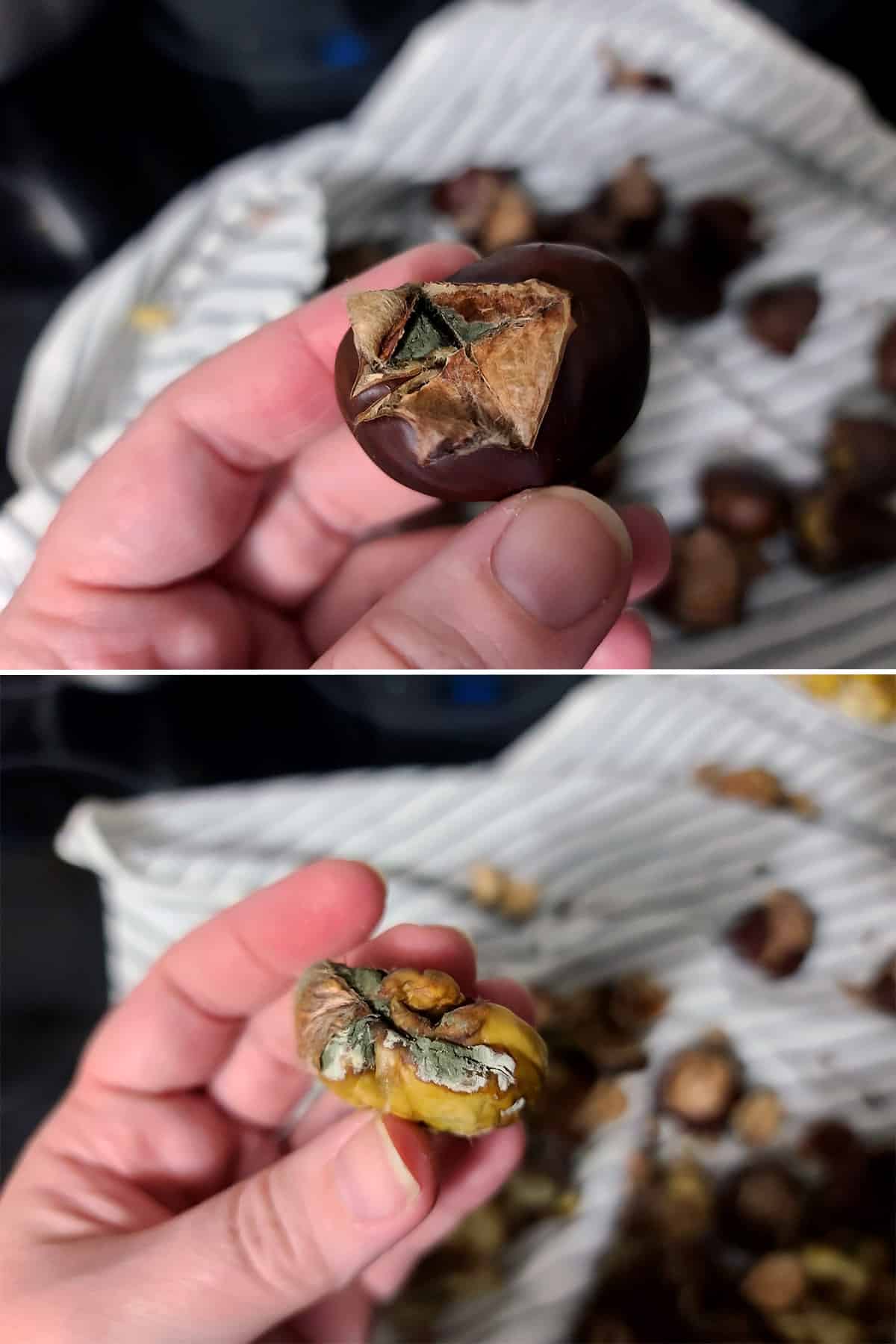
Boil the Chestnuts
This step is optional, but I find it makes for easier peeling, later.
Place the scored chestnuts in a large pot, and cover with cold water.

Note: Alternately, you can try soaking chestnuts in a bowl of hot water for 1 hour or so.
Personally, I prefer the quick boil. Less time til we’re munching roasted chestnuts = the best way, IMHO!
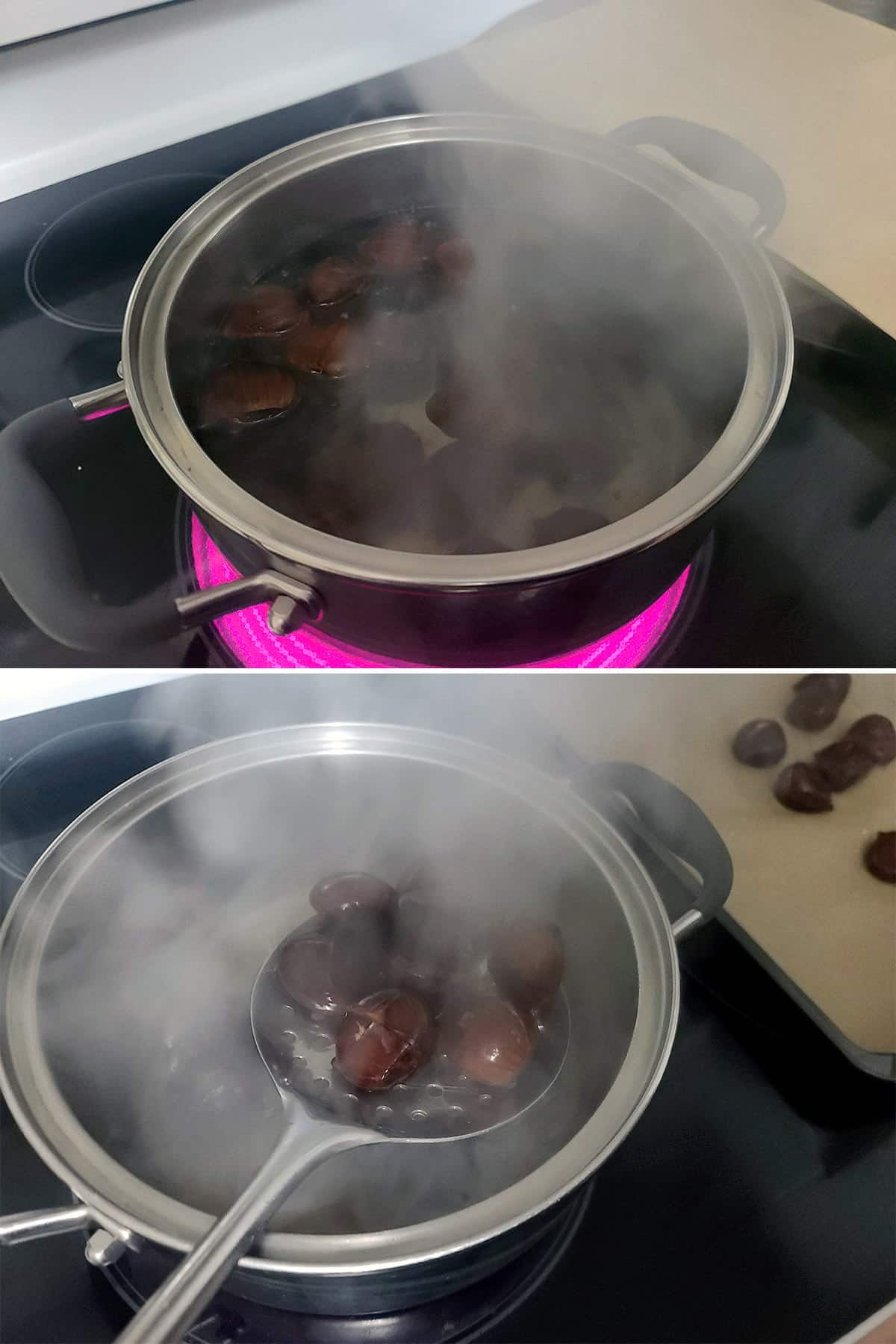
Spread the strained chestnuts out in a single layer on a baking pan - flat sides down, scored sides up.

Roast the Chestnuts
Place chestnuts in the preheated oven, and roast chestnuts until they are fragrant and have the edges of the “X” peeled back.
The roasting time can vary, I find it’s usually about for 10-15 minutes (if boiled) or 15-20 minutes (if not boiled).
Keep an eye on them - you don’t want to overcook or burn them!
Once the cooking process is done, take them out of the oven and immediately dump them in the center of the dish towel.
Wrap them up completely, and let them steam in the towel for 10 minutes.

Peel and Serve!
Once the steaming time is up, give the towel a good squeeze, to break some of the shells up.
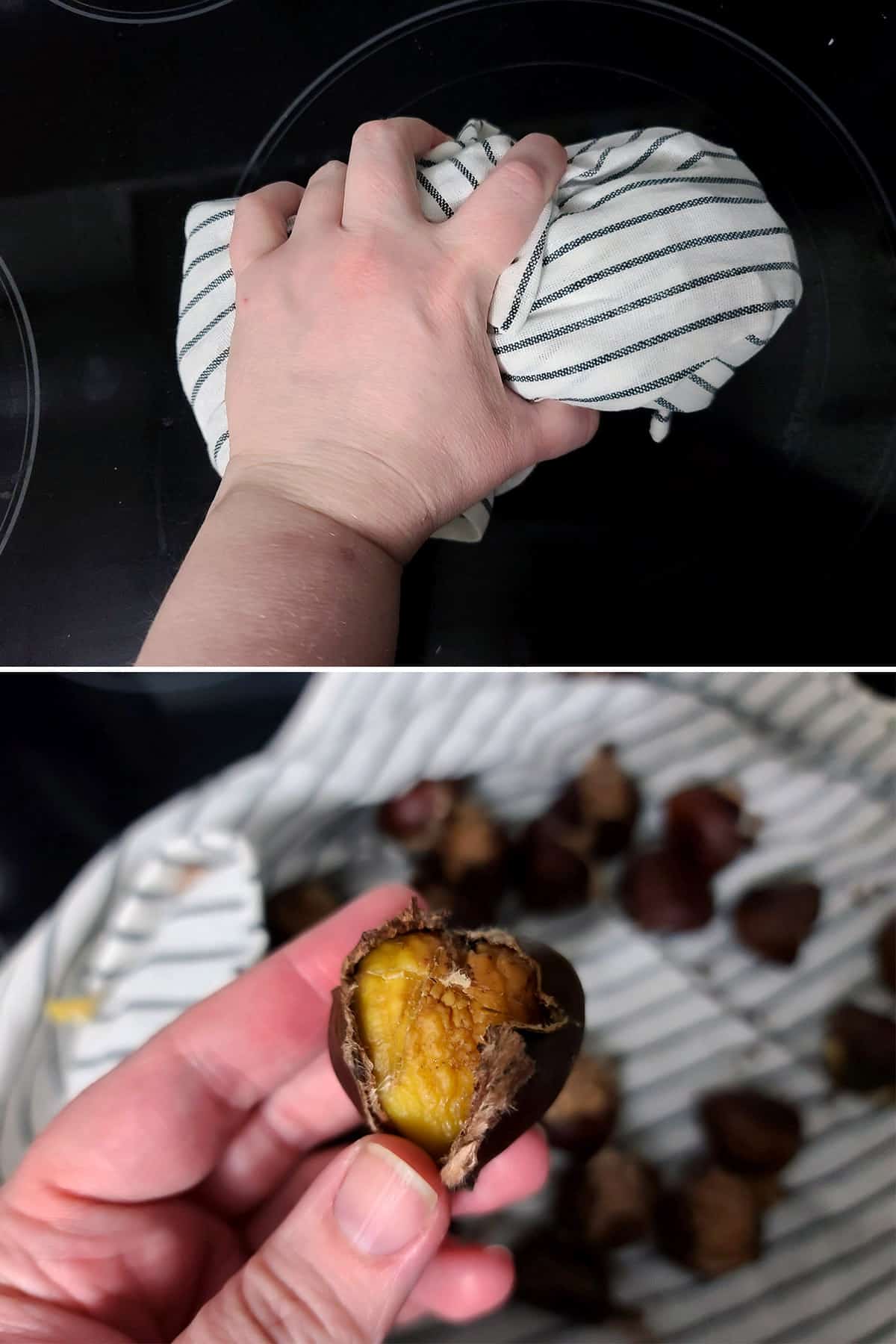
Remember: You’ll get the best result by peeling them when they’re still hot.
Once they’ve cooled to room temperature, the inner skin is so much more difficult to peel off!

You want to give them a firm crunch, but try for less... enthusiasm.. than I tend to squish them with!
When I’m using roasted chestnuts to make my Mushroom Chestnut Stuffing, I’ll usually roast them early in the morning - or the day before.
I usually make that stuffing for Thanksgiving, so I like to get the chestnut roasting out of the way in advance, rather than when I’m juggling Thankgiving dinner prep!
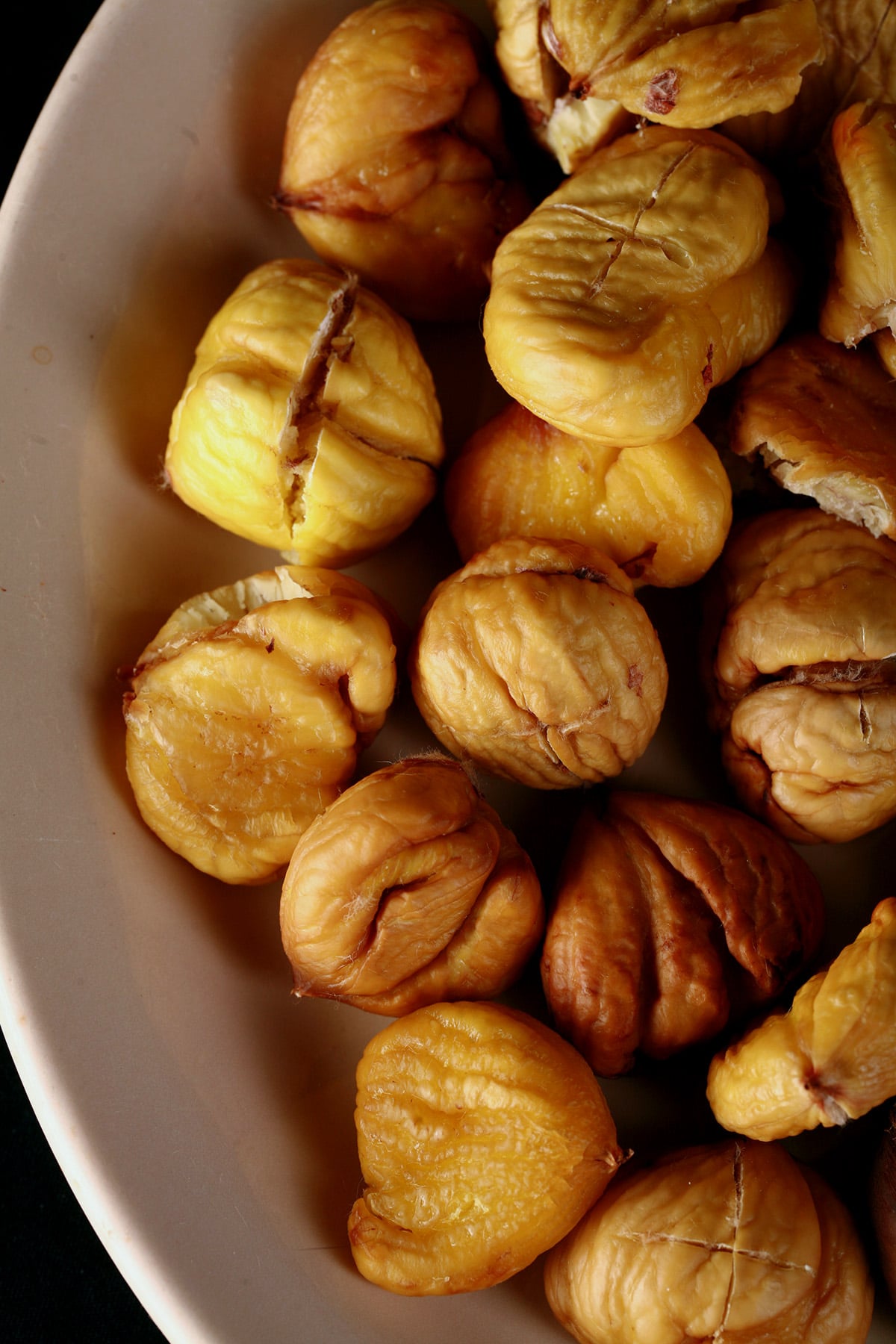
More Fall Eats
Looking for more cool weather, “autumn” type recipes to enjoy as the leaves change? I’ve got you!
Acorn Squash Tortellini with Nutmeg Cream Sauce
Hearty Corn and Black Bean Soup
Homemade Hard Apple Cider
How to Cut & Serve Pomegranate
How to Make Candy Apples
How to Make Pumpkin Mead
Maple Pumpkin Spice Bagels
Roasted Cauliflower Soup with Smoked Serrano Drizzle
Traditional Pumpkin Mousse
Wild Rice & Sausage Stuffed Peppers
Wild Rice Stuffed Chicken Breast

Share the Love!
Before you chow down, be sure to take some pics of your handiwork! If you post it to Bluesky, be sure to tag us - @CelebrationGen. We're also on Pinterest, so you can save all your favourite recipes to a board!
Also, be sure to subscribe to my free monthly email newsletter, so you never miss out on any of my nonsense. Well, the published nonsense, anyway!
Finally, if you love this recipe, please consider leaving a star rating and/or a comment below, and maybe even sharing this post on social media!
How to Roast Chestnuts [Oven Roasted]
Equipment
- Paring Knife
- Cutting Board
- Large pot
- Baking Sheet
- Kitchen Towel
Ingredients
- 2 lbs Chestnuts
- water
Instructions
- Start out by preheating your oven to 425 F.
Score Your Chestnuts
- I take a very sharp paring knife, and carefully poke the tip into the rounded side of a chestnut. Then I use that as sort of a pilot hole, my “in” to cutting an X across the rounded top.
- Cut that X shape across the top of every one of your chestnuts. If you come across any that have visible mold or smell bad, throw those ones out. I also throw out any that are obviously dried out.
Boil the Chestnuts
- This step is optional, but I find it helps when it comes to peeling them, later.
- Place the scored chestnuts in a large pot, and cover with cold water.
- Bring the water to a boil, then strain the chestnuts out as soon as the water starts actually boiling.
- Spread the strained chestnuts out on a baking sheet - flat sides down, scored sides up.
Roast the Chestnuts
- Place the chestnuts in the preheated oven, and roast for 15-20 minutes, or until they are fragrant and have the edges of the “X” peeled back.Keep an eye on them - you don’t want to overcook or burn them!
- Once they’re cooked, take them out of the oven and immediately dump them in the center of the dish towel. Wrap them up completely, and let them steam in the towel for 10 minutes.
Peel and Serve!
- Once the steaming time is up, give the towel a good squeeze, to break some of the shells up.
- Unwrap them, peel, and eat!


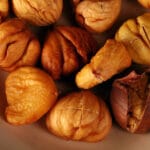


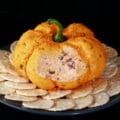





Leave a Reply